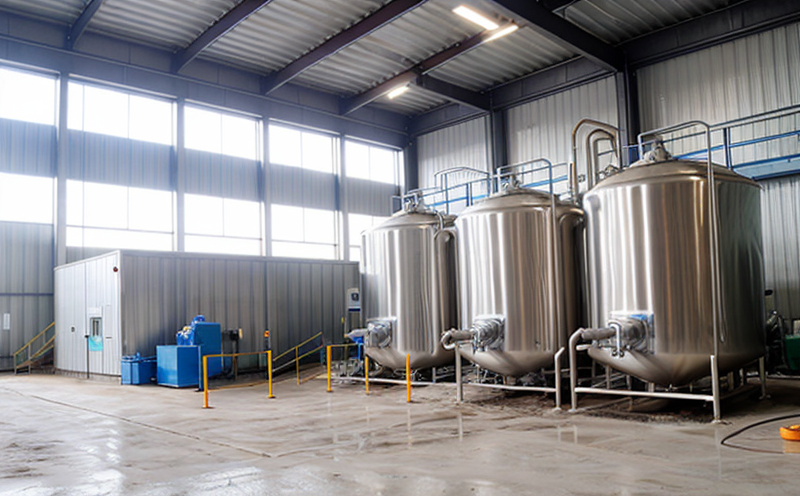ASTM D511 Calcium and Magnesium Hardness Test in Industrial Water
The ASTM D511 test method is a standardized procedure for determining calcium and magnesium hardness in industrial water. This test is crucial for quality managers, compliance officers, R&D engineers, and procurement teams as it ensures the effectiveness of water treatment processes in various industries such as power generation, oil refining, and chemical manufacturing.
Hardness in industrial process water can have significant implications on the performance of equipment and the efficiency of production processes. High levels of calcium and magnesium ions (Ca²⁺ and Mg²⁺) can lead to scaling within boilers and cooling towers, which reduces heat transfer efficiency. This results in increased energy consumption and potential damage to equipment over time.
The ASTM D511 test measures total hardness by titrating water samples with EDTA solution until a specific color change is observed. The amount of EDTA used directly correlates to the concentration of calcium and magnesium ions present, allowing for accurate quantification of these components in industrial process waters.
Preparation of the sample is straightforward; it involves collecting representative water samples from various points within the facility's water distribution system. These samples should be stored properly at room temperature until analysis can take place. Properly trained technicians then perform the titration according to ASTM D511 guidelines, ensuring consistent and reliable results.
Understanding the results of this test is essential for maintaining optimal operating conditions in industrial processes. By monitoring calcium and magnesium levels regularly using ASTM D511, operators can implement necessary adjustments to prevent scaling issues while optimizing water usage efficiency. This not only improves operational performance but also contributes positively towards sustainability goals by reducing resource consumption.
The importance of this test extends beyond just operational efficiencies; it plays a vital role in environmental stewardship too. By keeping track of calcium and magnesium hardness levels, facilities can minimize their impact on local ecosystems by reducing the amount of treated wastewater discharged into natural water bodies. This aligns with broader sustainability initiatives aimed at preserving environmental health.
Let's delve deeper into why choosing this particular test is beneficial for your organization:
Why Choose This Test
Selecting the ASTM D511 calcium and magnesium hardness test offers several advantages over other testing methods. Firstly, its reliability comes from being an internationally recognized standard (ASTM D511), ensuring consistency across different laboratories worldwide. Secondly, it provides precise measurements necessary for accurate process control. Precision is critical when dealing with sensitive industrial processes where even small variations could lead to significant operational disruptions.
Moreover, this test helps identify potential areas of concern early on in the water treatment cycle, allowing corrective actions to be taken before they escalate into larger problems. Early detection of issues like scaling or corrosion can prevent costly repairs and downtime. Additionally, compliance with industry-specific regulations becomes easier when relying on a standardized testing method like ASTM D511.
For organizations focused on sustainability, choosing this test supports their efforts by providing data that aids in reducing waste generation through optimized water usage practices. By minimizing the amount of untreated wastewater released into the environment, these facilities contribute positively towards environmental conservation goals.
Environmental and Sustainability Contributions
The ASTM D511 calcium and magnesium hardness test not only serves practical purposes within industrial settings but also contributes significantly to environmental sustainability. By accurately measuring these key ions in industrial process waters, facilities can make informed decisions regarding their water treatment processes.
One major contribution lies in the prevention of scaling events within critical equipment such as boilers and cooling towers. Scaling reduces heat transfer efficiency, leading to increased energy consumption and potential damage to equipment over time. Regularly performing ASTM D511 tests allows operators to monitor calcium and magnesium levels closely, enabling timely interventions that prevent these adverse effects.
In addition to operational benefits, adopting this test method supports broader sustainability goals by reducing resource waste. By optimizing water usage based on the results of ASTM D511 tests, facilities can minimize the amount of untreated wastewater discharged into local ecosystems. This helps preserve environmental health and aligns with initiatives aimed at protecting natural resources.
The precision offered by ASTM D511 ensures that corrective actions are implemented only when necessary, avoiding unnecessary expenses associated with over-treatment or under-treatment scenarios. Proper management of calcium and magnesium hardness levels contributes to efficient resource utilization, ultimately supporting sustainability efforts within industrial operations.
Use Cases and Application Examples
| Use Case / Application Example | Description |
|---|---|
| Cooling Tower Efficiency Monitoring | Determine optimal makeup water addition rates to prevent scaling and maintain heat transfer efficiency. |
| Boiler Water Treatment Optimization | Identify appropriate treatment chemicals needed to control calcium and magnesium hardness levels. |
| Water Reclamation Systems Monitoring | Analyze reclaimed water quality before reuse, ensuring compliance with discharge standards. |
| New Facility Design Planning | Conduct initial assessments to determine baseline calcium and magnesium hardness values for future reference. |
| Plant Maintenance Scheduling | Use test results to schedule maintenance activities during periods of lowest demand when scaling risks are highest. |
| Energy Consumption Reduction Strategy | Monitor calcium and magnesium levels over time to identify opportunities for improving energy efficiency through better water management practices. |
| Sustainability Reporting | Incorporate test results into sustainability reports demonstrating commitment to responsible resource use. |
| Compliance Audits Preparation | Ensure all necessary documentation is available for regulatory inspections related to water quality standards. |
The ASTM D511 calcium and magnesium hardness test serves as a cornerstone in various industrial applications, from optimizing cooling tower performance to scheduling maintenance tasks. Its role in supporting sustainability goals by minimizing environmental impact cannot be overstated. By leveraging this standardized testing method effectively, organizations can achieve both operational excellence and environmental stewardship.





